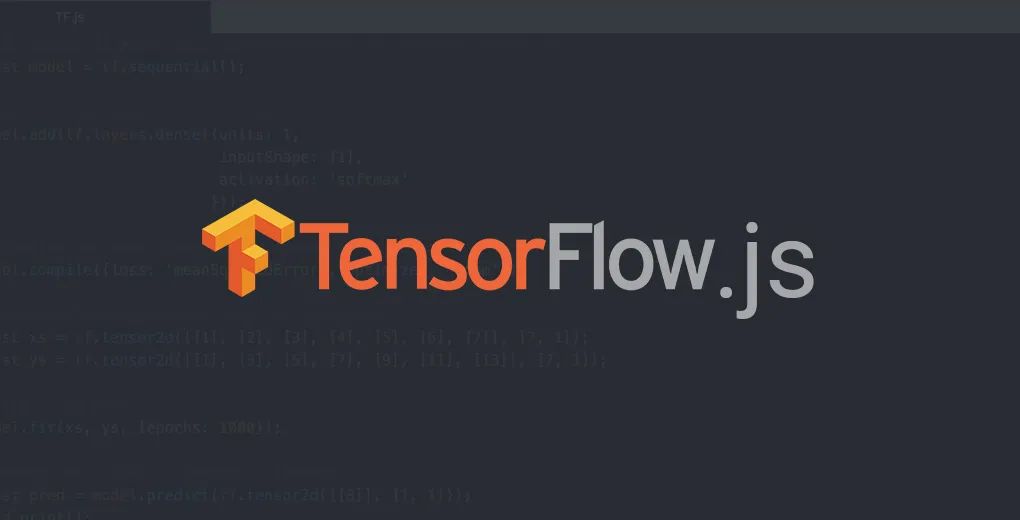TensorFlow.js 入门指南:让你的JavaScript应用拥有机器学习能力
TensorFlow.js 入门指南:让你的JavaScript应用拥有机器学习能力

随着机器学习技术的普及,不再仅限于Python和数据科学专家。通过TensorFlow.js,你可以将强大的机器学习能力带入你的JavaScript应用中。不论是网页、移动端还是桌面应用,集成机器学习都能显著提升功能性和用户体验。在本指南中,我们将探讨如何设置TensorFlow.js,构建和训练模型,并实现实际应用。
机器学习与TensorFlow.js简介
在深入细节之前,让我们先了解一些基本概念。机器学习是人工智能(AI)的一个子集,能够使系统从数据中学习,并在没有明确编程的情况下随着时间的推移提高其性能。
TensorFlow.js是由Google开发的一个开源库,允许你直接在浏览器和Node.js环境中定义、训练和运行机器学习模型。
为什么选择TensorFlow.js?
使用TensorFlow.js有以下几个优点:
- 跨平台:可以在浏览器、Node.js、移动设备,甚至物联网设备上运行模型。
- 高性能:利用WebGL在浏览器中进行GPU加速计算。
- 易于使用:借助JavaScript丰富的生态系统和对Web开发者的熟悉度。
- 实时应用:在浏览器中直接实现实时机器学习应用。
要深入了解TensorFlow.js的功能,可以查看官方文档。
https://www.tensorflow.org/js
设置TensorFlow.js项目
让我们从设置一个基本的TensorFlow.js项目开始。你可以在浏览器和Node.js环境中使用TensorFlow.js。
在浏览器中使用TensorFlow.js
创建一个新的项目目录:
mkdir tfjs-project
cd tfjs-project
初始化一个新的Node.js项目:
npm init -y
安装TensorFlow.js:
npm install @tensorflow/tfjs
创建一个HTML文件:
<!DOCTYPE html>
<html lang="en">
<head>
<meta charset="UTF-8">
<title>TensorFlow.js Example</title>
</head>
<body>
<script src="node_modules/@tensorflow/tfjs/dist/tf.min.js"></script>
<script src="main.js"></script>
</body>
</html>
创建一个JavaScript文件:
import * as tf from '@tensorflow/tfjs';
// 定义一个简单的模型
const model = tf.sequential();
model.add(tf.layers.dense({units: 1, inputShape: [1]}));
// 编译模型
model.compile({optimizer: 'sgd', loss: 'meanSquaredError'});
// 生成一些训练用的合成数据
const xs = tf.tensor2d([1, 2, 3, 4], [4, 1]);
const ys = tf.tensor2d([1, 3, 5, 7], [4, 1]);
// 训练模型
model.fit(xs, ys, {epochs: 10}).then(() => {
// 使用模型进行预测
model.predict(tf.tensor2d([5], [1, 1])).print();
});
运行本地服务器:使用http-server工具本地运行文件。
npm install -g http-server
http-server
在Node.js中使用TensorFlow.js
创建一个新的项目目录:
mkdir tfjs-node-project
cd tfjs-node-project
初始化一个新的Node.js项目:
npm init -y
安装TensorFlow.js for Node.js:
npm install @tensorflow/tfjs-node
创建一个JavaScript文件:
const tf = require('@tensorflow/tfjs-node');
// 定义一个简单的模型
const model = tf.sequential();
model.add(tf.layers.dense({units: 1, inputShape: [1]}));
// 编译模型
model.compile({optimizer: 'sgd', loss: 'meanSquaredError'});
// 生成一些训练用的合成数据
const xs = tf.tensor2d([1, 2, 3, 4], [4, 1]);
const ys = tf.tensor2d([1, 3, 5, 7], [4, 1]);
// 训练模型
model.fit(xs, ys, {epochs: 10}).then(() => {
// 使用模型进行预测
model.predict(tf.tensor2d([5], [1, 1])).print();
});
运行你的Node.js脚本:
node main.js
构建和训练机器学习模型
现在我们已经设置好了TensorFlow.js环境,接下来让我们深入了解如何构建和训练机器学习模型。
定义模型
在TensorFlow.js中,你可以使用顺序API或功能性API定义模型。顺序API适用于简单的、可堆叠的层,而功能性API则更灵活,可以处理更复杂的架构。
示例:顺序模型
const model = tf.sequential();
model.add(tf.layers.dense({units: 10, inputShape: [4]}));
model.add(tf.layers.dense({units: 1}));
model.compile({optimizer: 'adam', loss: 'meanSquaredError'});
示例:功能性模型
const input = tf.input({shape: [4]});
const dense1 = tf.layers.dense({units: 10, activation: 'relu'}).apply(input);
const output = tf.layers.dense({units: 1}).apply(dense1);
const model = tf.model({inputs: input, outputs: output});
model.compile({optimizer: 'adam', loss: 'meanSquaredError'});
训练模型
训练模型包括为其提供数据,并指定epochs(数据集的迭代次数)和batch size(每次梯度更新的样本数)。
const xs = tf.tensor2d([[1, 2, 3, 4], [2, 3, 4, 5]], [2, 4]);
const ys = tf.tensor2d([[5], [7]], [2, 1]);
model.fit(xs, ys, {epochs: 10, batchSize: 2}).then(() => {
model.predict(tf.tensor2d([[3, 4, 5, 6]], [1, 4])).print();
});
实际应用案例
让我们探讨一些将机器学习集成到JavaScript项目中的实际应用。
图像分类
图像分类涉及从预定义的类别集合中为图像分配标签。
示例:使用预训练模型
const img = document.getElementById('image');
const model = await tf.loadGraphModel('https://tfhub.dev/google/tfjs-model/imagenet/mobilenet_v2_140_224/classification/3/default/1');
const tensor = tf.browser.fromPixels(img).resizeNearestNeighbor([224, 224]).toFloat().expandDims();
const predictions = await model.predict(tensor).data();
console.log(predictions);
自然语言处理(NLP)
NLP任务包括文本分类、情感分析和语言翻译。
示例:情感分析
const model = await tf.loadLayersModel('https://tfhub.dev/google/tfjs-model/toxicity/1/default/1/model.json');
const sentences = ['I love this!', 'I hate this!'];
const predictions = await model.classify(sentences);
predictions.forEach((p, i) => {
console.log(`${sentences[i]}: ${p.label} - ${p.results[0].match}`);
});
实时对象检测
对象检测涉及识别图像中的对象并定位它们。
示例:使用预训练模型
const video = document.getElementById('video');
const model = await tf.loadGraphModel('https://tfhub.dev/tensorflow/tfjs-model/coco-ssd/1/default/1/model.json');
const detectObjects = async () => {
const predictions = await model.detect(video);
console.log(predictions);
};
video.addEventListener('play', () => {
setInterval(detectObjects, 100);
});
性能考虑和优化技巧
在将机器学习模型集成到应用程序中时,考虑性能和优化是至关重要的。
使用WebGL进行GPU加速:TensorFlow.js可以利用WebGL进行GPU加速,从而显著提高性能。
const model = await tf.loadLayersModel('model.json',
{fromTFHub: true, useWebGL: true});
优化模型大小:较小的模型加载和运行更快。使用模型量化和剪枝技术来减少模型大小。
高效的数据处理:使用高效的数据结构和批处理来处理大型数据集。
分析和调试:使用TensorFlow.js内置的分析工具来识别和解决性能瓶颈。
结束
通过使用TensorFlow.js将机器学习与JavaScript集成,网页开发者可以打开一个充满可能性的世界。从设置第一个项目到构建和部署实际应用,TensorFlow.js使在JavaScript中利用机器学习的力量变得既可访问又高效。

